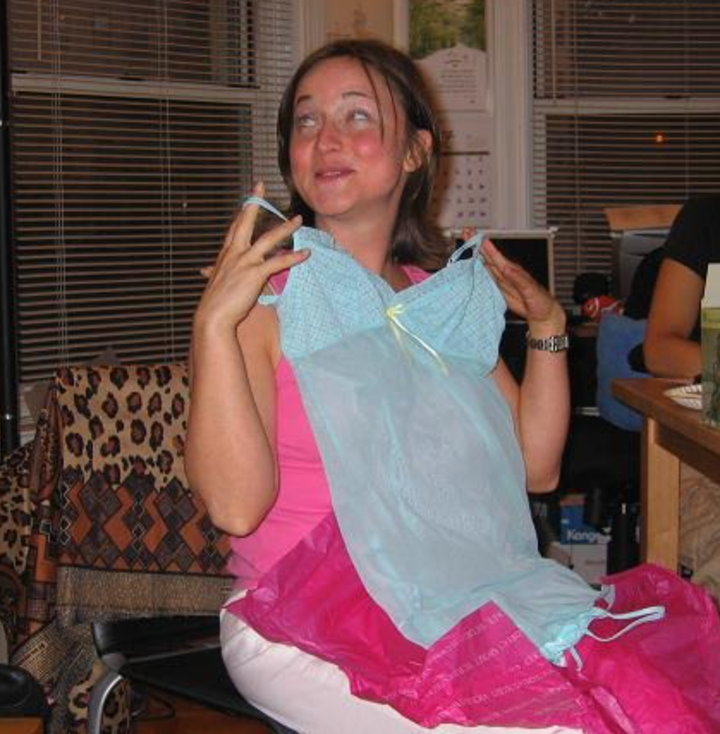
I met my husband in college, and we dated for five years prior to our wedding. I brought a whole host of fear-based ideas about sexuality to our marriage. Due to purity culture, which primarily targeted girls in the 1990s with a message that their sexual purity was their most prized asset, I could not help but believe a crown of stars awaited me if I stayed a virgin, possibly until death.
In my all-girl Catholic high school theology class, we had learned virginity was a gift. We were told to imagine our sexual purity as a beautifully wrapped present. If we ever felt pressured to give in to the sexual advances of our male counterparts, we were to consider what it would be like to hand our future spouse a gift with tattered wrapping paper and bedraggled ribbons.
As I entered college and wrestled with my faith, the book “I Kissed Dating Goodbye,” written by a young pastor named Joshua Harris, caused a huge splash in Christian circles. It offered what he called a blueprint for a successful courtship that would lead to marriage and encouraged heterosexual couples to limit physical contact until the male partner was prepared to ask for the female’s hand in marriage. Then sex would be blessed by God. Then sex would be safe.
Prior to our engagement, I had converted to my soon-to-be husband’s faith, and together we attended Bible studies and spent whole weekends with our church community. I gave away my jewelry and dressed modestly. I hoped that God would look fondly on our relationship and that once we were married, all of my worries and fears about sex and sexuality would vanish.
However, the problem with a belief system that positions one’s sexuality as God-given and God-approved but which can only be shared in a committed heterosexual marriage is that it’s entirely transactional. Who am I as a sexual being, irrespective of my future partner(s)? was never a question I was encouraged to ask or explore before my wedding. I was given “a gift,” I was to keep it wrapped and then I would supposedly enjoy it once I got married.
The formula prescribed by purity culture did not deliver the results I expected. Committing to abstinence required me to see sex as a toxic substance outside of marriage, and there was no guidance for shifting that narrative on my wedding night. I went from being a virginal bride to one who had no idea about the mechanics of sex, what my body was capable of, what I desired, what felt good or how to communicate any of this to my partner.
Once I was married, I was constantly paranoid that I was not having enough sex and that I was doing it wrong when I was having it. None of this messaging came from my husband. It was simply the byproduct of all the troubling things I’d been taught my entire life.

In church circles, I heard about the importance of good wives making themselves available and pleasing to their spouses. I rarely if ever heard the same for husbands. After our first year of marriage, I became pregnant, and then a year later I became pregnant again. In spite of the grace my husband offered me during our sleepless years, my hang-ups over not having enough sex remained and even intensified.
When my children were still young, I took a job teaching at a Bible college in Tennessee. I was surprised at how many of my students married while they were still undergrads. Some of them were barely out of high school.
I frequently overheard these young women discussing their two bridal showers: one thrown by elders to receive housewares and another thrown by friends to receive lingerie. It was a two-pronged preparation for the bride that said: Here is what you will need for your home and for your husband.
But where was the ritual to prepare a young woman who was not getting married ― but who was still a whole person? I wondered. Does she not still need a cast iron pan? Does she still not deserve beautiful undergarments?
I tentatively began to look for answers, but most of the books and podcasts I found in the 2010s that spoke to sexuality within monogamy skirted the issue of female desire. I was still hearing sermons about sexual purity as an absolute, and reading blogs by women who endorsed frequent sex as a safeguard against a husband’s infidelity.
Then an unlikely source helped me to course correct. I read an account of an American expatriate in France who discovered that French women reportedly spent 20% of their income on lingerie. At first I couldn’t believe all of these women were forking over so much money on something that most people would never see, but I realized they were doing it for themselves. To please themselves. To feel good about themselves.
I started to amass my own wardrobe of lingerie. I still wore the modest suits of a professor, but underneath were the reminders that I was more than a teacher with sensible shoes.
In 2018, Joshua Harris denounced “I Kissed Dating Goodbye” and publicly apologized for the hurt caused by it. The following year, Lutheran pastor Nadia Bolz-Weber published “Shameless,” an indictment of the shame-laced ways the church has indoctrinated young people about sexuality.
By this point, I was beginning to lose my footing in my own marriage. My husband and I had moved across the country and were navigating new jobs and life with adolescent children. Natural growing pains were surfacing: We were two people who met before our brains were fully developed — before we knew who we truly were. The strains of our life together were pulling us apart.
I started to visit social media accounts about lingerie as a way to relieve stress. Learning about the materials, the construction, the history and the style of the pieces was soothing. I also discovered the women running these accounts, like the French women I’d read about years earlier, wore their lingerie not for a partner but for themselves. They were celebrating their own sexuality.
Perhaps this was Victoria’s Secret: not that she used a satin chemise to attract but that she kept a ruffle-trimmed slip in her boudoir to remind her of who she was.
Seventeen years after we wed, my husband and I met in a courtroom, and, with the stroke of a judge’s pen, our relationship was legally dissolved. My marriage was my only significant romantic relationship, and I mourn the familiar rhythms of that life. I am left with countless existential questions about what I do now, what I want... and an expansive wardrobe of lingerie.
For the first time in over two decades, I am single. I am not afraid of falling in love again, but I am afraid of abandoning myself to someone else’s narrative about who I am. I go on dating apps, sift through pictures of men flexing their muscles and cuddling their dogs, and then I delete the apps.
In therapy, I discuss my hang-ups about all of this.
“What is the purpose of dating? For you?” my therapist asks. I do not have a clear answer, but I know those two words, “for you,” are essential.

I am 43 years old and just now beginning to unpack what sex and monogamy mean for me — and not because a pastor or book club defined it for me. I am still a person of deep faith, but I am no longer a member of a church. I am in a season of deconstructing beliefs that have done me far more harm than help.
The path forward for me may be paved with rubble, but it is edged with lace and satin. In this new chapter, which I could never have envisioned as a young newlywed, I realize what all these lingerie-loving women I’ve come across know about intimate apparel: It is a symbol of their superpower. They wear pieces that allow them to simply feel good in their bodies.
When we feel good in our bodies, we can talk back to the shame. We can celebrate the marvelous capacity our bodies have to experience desire and pleasure. This is a wondrous thing ― no matter one’s size, shape, skin color or creed. Obviously, wearing lingerie is just one of countless ways through which a person can access that freedom, but for me (and many others), it serves as a gentle yet potent reminder of my commitment to seeking the kind of liberation that has eluded me for much too long.
Recently I purchased a luxurious royal blue loungewear set. It sits in a gold cardboard box, tied with a matching royal blue ribbon. I have not decided if I will wear the set for a special occasion, like when I find true love again, or simply when I’m having a good hair day. What I do know is that the decision is not one to fear — especially because I am the one making it.
Kendra Stanton Lee is a teacher and writer in Boston. Her work has appeared in The Washington Post’s “On Parenting” feature, The Boston Globe, Slate and other publications. You can find more of her writing at www.kendrastantonlee.com.
Do you have a compelling personal story you’d like to see published on HuffPost? Find out what we’re looking for here and send us a pitch at pitch@huffpost.com.
